Young Game Designer Course: How to count the balance of characters and equipment without mathematics
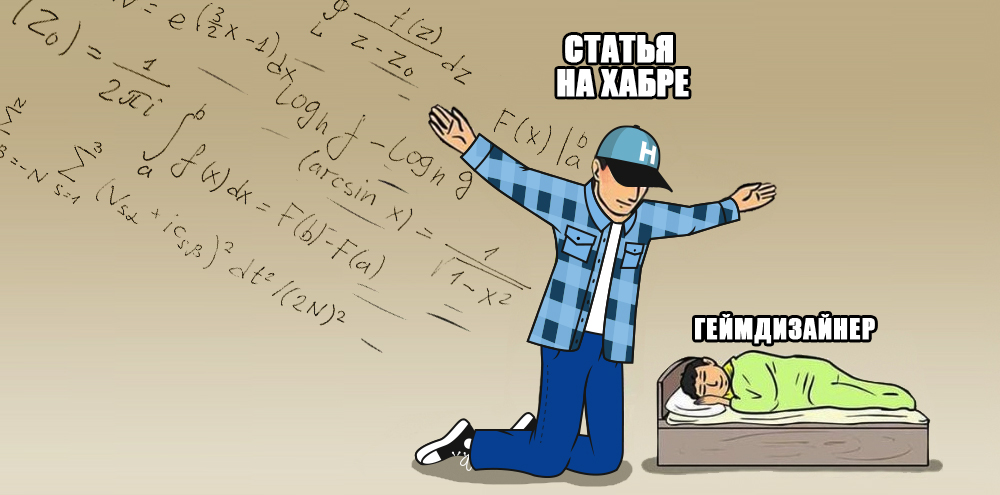
By experience, many novice game designers avoid working with balance, as if it is black magic or you need to have a serious mathematical education. Experts are more empirically authoritatively claiming that mathematics is not needed .
First of all, you need to understand the games themselves, and then be able to count something. Therefore, I will talk about working with balance without using mathematics - on sticks of damage we will see how to balance the strength of a weapon, how a tank differs from a robber, and how spawn points affect winrate.
')
The article will be useful to those who need to do the balance, but does not know where to start, as well as novice game designers who will choose a specialization. Well, to everyone who is simply interested in what the State Duma is doing
We will not go too deep into the details of specific calculations. Practical advice is enough on the Internet: there is a series of articles on the balance on the State Duma's cuffs , in the blog of our producer Anatoly Shestov there are translated lectures by Jan Schreiber . There you can find answers to many questions if they appear during the reading. I advise you, if you do not scare the abundance of numbers and calculations.
And I will tell you where to look and what to pay attention to. Because the accuracy of calculations is a matter of technique and experience. The main thing to start.
The basis of the basics
In any game with battles there are combat units. Units in the RTS, characters in the RPG, opponents in shooters. They have combat parameters that depend on the design goals: whether we want to make the unit a cannon fodder, an epic opponent or something else.
Since we are talking about battles, units should have the power of damage. Imagine this damage stick. These sticks are disposable - when a unit uses it, it disappears.

Most likely the unit has several such sticks. Their number depends on how long he lives. If a unit lives 5 rounds and spends one stick per round, it means it has 5 damage sticks.
Together they make up the combat strength of a unit, and if you put sticks to each other, you get a rectangle:
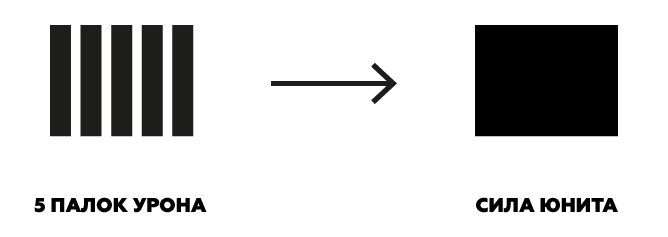
Therefore, the first thing to remember:
Unit Strength = Unit Damage * Life Span (HP)
Everything else we take from the knowledge of games and common sense. Suppose a rectangle in the picture describes the strength of a certain unit. For example, Paladin in RPG.
Usually in role-playing games there are much more parameters than HP and damage - there are chances of crit and dodging, attack distance, speed and so on. But one way or another, all these properties can be reduced to the equivalent of damage or lifetime. Double attack speed means that for a round a unit deals double damage, and the 50% chance of dodging adds to the unit the same lifetime as if we doubled its HP.
Too much math, back to the sticks. Different units of stick damage can be of different lengths (forces). And the lifetime (rounds) also happens different:
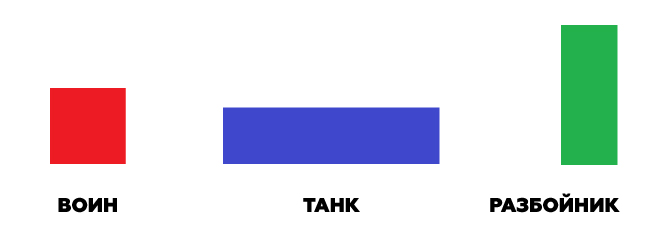
These are typical character classes in RPG. Warrior is usually the most average. The tank lives for a long time, but does less damage. The robber is a glass cannon, it does not live long, but it does a lot of damage.
But how to understand if these classes are balanced with each other ?? You could already know the answer - you just need to calculate the area of the rectangles . If they are the same, then the classes have the same power and they are in balance with each other.
Now we will make our tank more interesting. Think about this character:

Behind this figure is the Berserker - a tank that receives a bonus to damage when it has low health. Its strength is also equal to the area of the figure in the figure — it is considered as the sum of two rectangles.
The first skill of the balancer is to see the gameplay behind abstractions. Behind the rectangles, behind the sets of numbers. If you learn to describe the gameplay in the schemes (even such primitive), numbers and parameters, it will work in the opposite direction - looking at the numbers, you begin to imagine how it will be played.
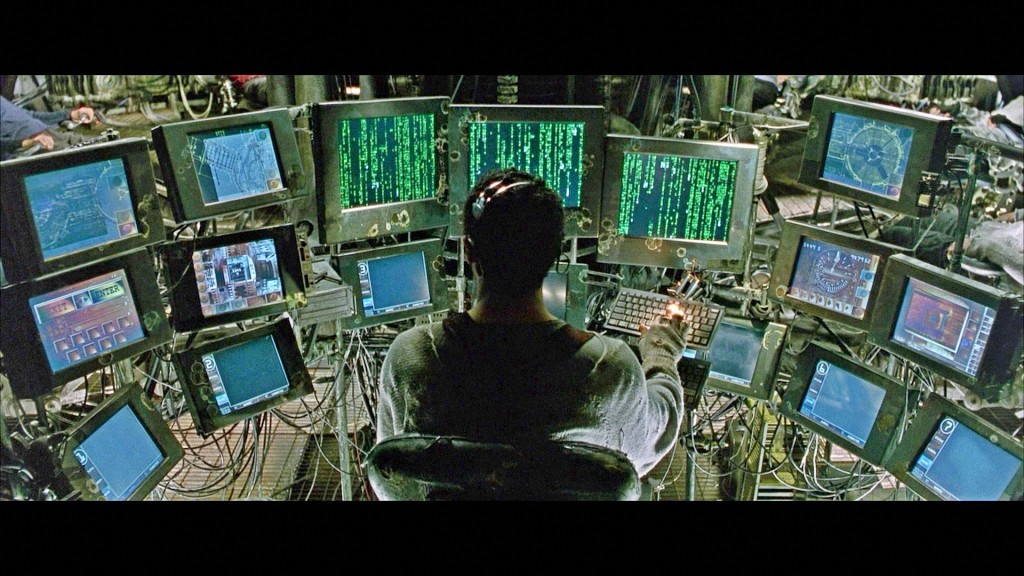
Equipment balance
In the RPG there are not only characters, but also equipment. For example, swords. How to calculate the balance of the sword? Similar.
The sword has some damage, but no time to live. The sword "lives" as much as the player wants to use it, and we do not know how much it is. Well, okay. Just say that a sword lives 100% of its life.
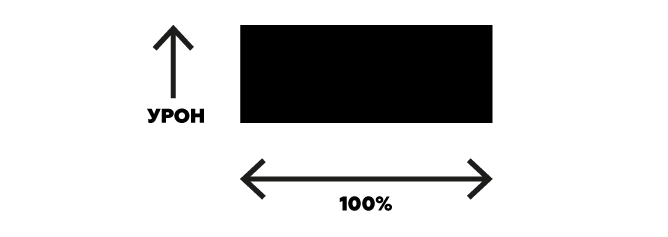
Thus, the sword with the greatest damage will be stronger (because all swords live 100% of the time). But what if we have the Goblin Ripper in our hands, who does double damage to them? How to understand how much he is stronger than an ordinary sword?
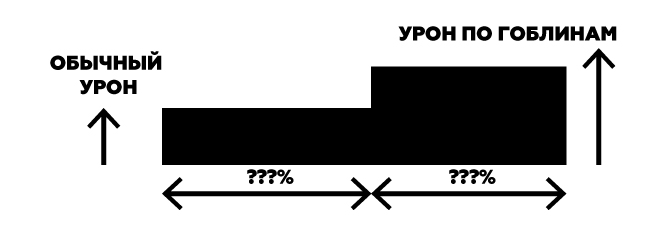
We know that the sword lives 100% of the time, but we don’t know which part of it is normal damage and which part is double. This we can easily learn from our colleagues who are engaged in missions / levels.
Suppose a third of all enemies in the game are goblins. This means that one-third of her sword’s life deals double damage and two-thirds normal. Now we can compare it with conventional weapons. A standard sword has 1 damage * 100% = 1 strength. The Goblin Ripper has 1 damage * 67% + 2 damage * 33% = 1.33 strength. That is, it is 33% stronger than a regular sword. And if we want to make it equal in strength to an ordinary sword, we just have to reduce the normal damage of the Ripper Goblins .
Nothing complicated. If you can count squares of rectangles, then you know where to start the balance of units and equipment.
Situational balance
It is easy enough to compare the strength of 2 swords. They work the same, only with different damage. And if we have a shooter, machine guns, shotguns and sniper rifles? They work differently, give different feelings and require different strategies. Their strength depends on the situation in which you find yourself. For example, a shotgun is useless at long range, and a sniper is hard to handle when the enemy flashes right in front of his nose.
If you simplify - the sniper rifle will always win at a distance, and the shotgun will always win close. How do you know if they are equal in strength?
Suppose there are only two types of weapons in the game - shotguns and rifles. And two cards - a labyrinth and a corridor. The player is obliged to choose a weapon before he gets a card.
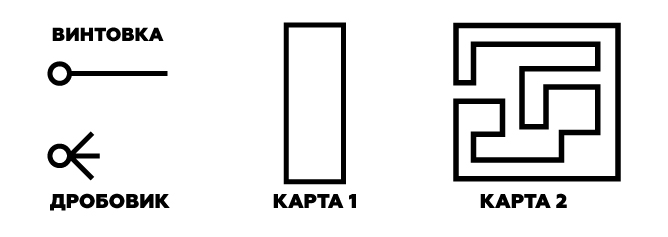
On the first map, the strength of the rifle is 100%, and the shotgun is 0% (the rifle always wins). The second is the opposite. To understand whether they are equal in strength on average, we need to understand how often this or that card falls. If the chance of dropping each card is 50%, then both types of weapons will be equal to each other. In any case, your chance to win will be 50%.
If you noticed, I missed some of the important rules - the point of appearance of the players. Even if you play in the hallway, but appear very close to each other, the shotgun will win. Therefore, the rules of the appearance of players, too, must be remembered.
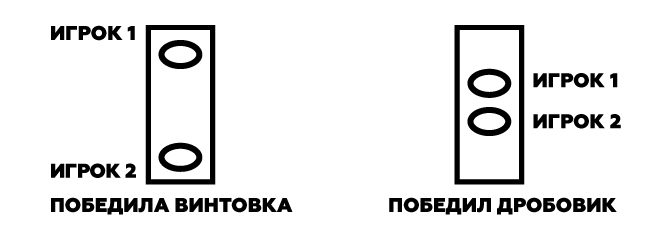
But what if we change the rules, and the player can choose a weapon after finding out the type of card? Then he can choose the best weapon on this card. In this case, to make sure that the player does not have the uniquely best choice - this is the task of the level designer. He needs to make sure that each card has an equal number of sections in which the rifle or shotgun will have an advantage. Now it will depend on the player's skill whether he can drag the hassle to where he has the advantage.
The balancer, in turn, must represent the structure of the card, understand how many sections of a particular type are on the map, and make the appropriate changes to the power of the weapon (as in the example with the Goblin Ripper).
If in our RPG we have a third of the enemies were goblins, then in the shooter we need to know how many percent of the map are corridors, and how many are cramped rooms. But the principle of this will not change.
The power of the weapon can be calculated in the same way: multiply the damage by the percentage of time when it has an advantage on the map. Therefore, it is quite possible that an imbalance of a gun (too strong or weak) is connected not with settings, but with a level design.
This principle can be extended further. There are many reasons why a weapon may be considered useless at a particular point in time. Take a shotgun and follow its life:
- The player appeared on the spawn point. Weapons are useless, because there are no enemies and cannot be near them.
- The player approached the center of the map and saw the enemy. The enemy is too far away - the shotgun is useless.
- The player goes to a rapprochement. In the middle distance you can shoot, but because of the scatter, half of the grains are flying past. Shotgun is only half useful.
- The player got to the enemy and shoots at close range. Maximum efficiency.
Now the average force of the shotgun can again be calculated as the sum of the areas of the rectangles:
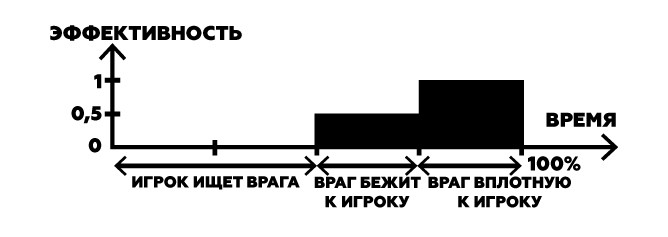
For another weapon, you can build another chronology. For example, with a sniper rifle, the player does not need to get close to the enemy, you just have to meet. Therefore, the rifle maximum efficiency will be in the middle of "life." And reduced efficiency at the end:
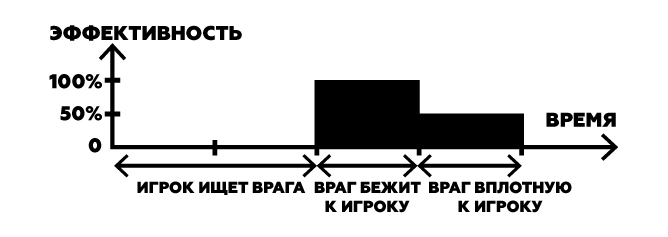
This is a deliberately simplified example. One can always calculate more precisely using smooth mathematical functions depending on the distance and accuracy of the weapon + to take into account more efficiency conditions and dependencies. The effectiveness of a weapon at some point may not be equal to 100% or 50%, but 37% or 42. And the area should be considered an integral of these functions. But the general principle will not change.
In order to correctly calculate the balance, first of all you need to know not mathematics, but how and by what rules your game works. Understand what happens at what moment, how events develop. We know that the balance of a weapon is influenced by the moment of its choice (before the map is known or after), spawn points, level design and the development of the match as the game progresses. The task to calculate the balance is to understand the game.
Preliminary results
We discussed the balance of individual entities, character or weapons. So far I have told you about the very basics - where to start when something needs to be balanced:
- Set goals. Because the calculations are not done in a vacuum.
- Understand how your game works. And what are the rules in it.
- Imagine what is happening in the game at any time.
- Determine how this situation affects the strength of what you want to balance.
And in the next article I will touch on more global things that are associated with the whole game: the interaction of balance, economy and player progression. There will be more about the dynamics of development and the impact of the fundamental rules of the game, such as the rules of battle.
UPD. And here is the second article .
Source: https://habr.com/ru/post/459504/
All Articles